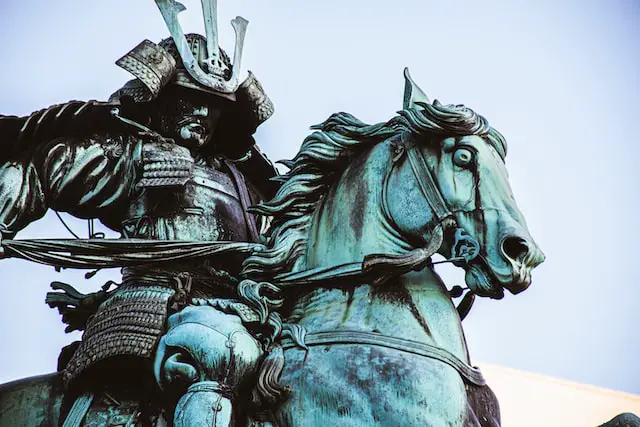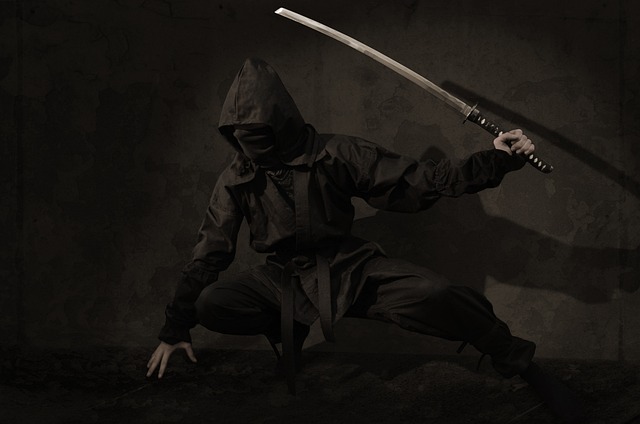While both Samurai and Ninja have played a significant role in Japanese culture, there are some clear differences between the two. The Samurai was a highly trained warrior of noble birth while the Ninja were mercenaries who practiced stealth tactics.
The samurai
The samurai were a class of warrior nobility in feudal Japan who served as the country’s military elite from the 12th century until the Meiji Restoration in 1868. They were trained in martial arts and swordsmanship and held to a strict code of honor known as Bushido, which emphasized loyalty, self-discipline, and respect for others.
Samurai were typically employed by feudal lords known as daimyo and were responsible for protecting their lord’s lands and people. They were also involved in internal conflicts and wars between different daimyo, often fighting on horseback and wearing distinctive armor and helmets.
The samurai were known for their skill with the sword, particularly the katana, and their emphasis on individual combat. They were also skilled archers and practiced various other martial arts, such as jujitsu and wrestling.
Although the samurai class was abolished during the Meiji Restoration, their legacy lives on in modern Japanese culture and media, with samurai stories and imagery remaining popular in Japan and around the world.
The ninja
The ninja, also known as shinobi, were covert agents in feudal Japan who specialized in espionage, sabotage, and assassination. They were trained in a variety of skills, including disguise, infiltration, and escape, and operated in secrecy.
Ninja were employed by various groups, including samurai clans, warlords, and wealthy merchants, and were often hired to carry out tasks that could not be accomplished through conventional means. They were known for their stealth and deception, using disguises and misdirection to carry out their missions.
Ninja also developed unique weapons and tools for their work, such as the shuriken throwing star, the kusarigama chain-sickle, and the grappling hook. They were also skilled in various forms of combat, including unarmed combat and the use of swords and other weapons.
Despite their reputation as deadly assassins, ninja were not always violent and sometimes employed non-lethal tactics to achieve their goals. They were often viewed with suspicion by the samurai, who considered them to be dishonorable and untrustworthy.
Today, ninja continue to be a popular subject in popular culture, with their image and mythology appearing in movies, television shows, and video games around the world.
Differences between a samurai and a ninja
While both samurai and ninja were warriors, there were several key differences between the two. For one, samurai were part of the noble class while ninja came from a lower social class. Samurai also had a code of honor that they followed known as bushido while ninja did not have such a code. Additionally, samurai fought openly while ninja tended to use more stealthy and underhanded tactics. Finally, samurai typically used swords as their primary weapon while ninja favored tools like daggers and shuriken.
The history of the samurai
(Photo by Ryunosuke Kikuno on Unsplash )

The samurai were a class of warriors in ancient Japan. They were known for their skill in battle and their code of honor. The samurai rose to power in the 12th century and ruled Japan for centuries. They were overthrown in the 19th century, but their legacy continues to this day.
The word “samurai” comes from the Japanese verb “saburau”, which means “to serve”. The samurai were a warrior class that served the nobles and the emperor. They were expected to be loyalty and courage in battle. The samurai followed a code of honor called bushido, which means “the way of the warrior”. Bushido emphasized loyalty, courage, discipline, and self-sacrifice.
The samurai first rose to power during the Heian period (794-1185). The noble families fought for control of the government, and the samurai became their mercenaries. In 1185, a military general named Minamoto Yoritomo seized power from the emperor and established the Kamakura Shogunate. The Kamakura Shogunate was ruled by a military dictator called a shogun. The shogun controlled all of Japan through his powerful Samurai warriors.
During the Kamakura period (1185-1333), the samurai reached their peak of power. They became more than just soldiers; they were administrators and statesmen as well. However, By 1333, the decline of the samurai’s power during the Kamakura period was also due to political instability and internal conflicts among samurai factions. The Kamakura Shogunate, which had been established by Minamoto no Yoritomo in 1192, began to weaken as successive shoguns faced challenges from other powerful samurai families.
The Mongol invasions of 1274 and 1281 also contributed to the decline of the samurai’s power. Although the Japanese repelled both invasions, the cost of defense and the loss of life took a toll on the country’s resources and economy.
Furthermore, the growth of the merchant class during the Kamakura period created social and economic tensions that threatened the samurai’s status and power. Merchants became increasingly wealthy and influential, challenging the traditional hierarchy of Japan and the samurai’s dominance over society.
Finally, by the end of the Kamakura period, the samurai had become more focused on cultural pursuits, such as poetry and tea ceremonies, than on martial training and warfare. This shift in focus weakened their military prowess and left them vulnerable to threats from external enemies and internal rivals.
Despite their decline in power during the Kamakura period, the samurai continued to play a significant role in Japanese society and history, and their legacy lives on in modern Japan and popular culture.
The history of the ninja
(Image by MichaelWuensch from Pixabay )

The ninja first appeared in Japanese history during the Kamakura period (1185-1333). They were mercenaries who were hired by feudal lords to do things that required stealth, such as spying and assassination. The ninja were often thought of as dark and evil because of the nature of their work.
During the Warring States period (1467-1568), the ninja rose to prominence as a powerful military force. They were skilled in guerrilla warfare and helped many warlords attain victory. The most famous ninja of this era was Hattori Hanzo, who was responsible for the assassination of Oda Nobunaga.
The Edo period (1603-1868) was a time of peace, and as a result, the ninja lost their status as warriors. Instead, they became spies and assassins for the shogunate. The Meiji Restoration (1868-1912) brought about an end to the shogunate, and with it, the Ninja faded into obscurity.
Samurai and ninja in pop culture
Since the early days of cinema, samurai and ninja have been popular subjects for filmmakers. Some of the most famous samurai movies include Akira Kurosawa’s “Seven Samurai” and “Yojimbo”, and more recent films like “The Last Samurai” starring Tom Cruise. Ninja films are also popular, with classics like “Revenge of the Ninja” and “American Ninja”.
More recently, samurai and ninja have appeared in many video games, cartoons, and comics. In the “Super Mario Bros.” video game series, there is a character named Ninji who is based on a ninja. In the “Teenage Mutant Ninja Turtles” franchise, one of the main characters is a ninja turtle named Leonardo. And in the popular manga and anime series “Naruto”, one of the main characters is a young ninja named Naruto Uzumaki.
There are also many real-life ninjas and samurai who perform shows and demonstrations at festivals and conventions. So if you’re ever curious about these two fascinating groups of people, be sure to check out some of these pop culture references!
Misconsecptions about the samurai and the ninja
In popular culture, the samurai and ninja are often portrayed as two sides of the same coin – either honorable warriors or shadowy assassins, depending on who you ask. But in reality, these were two very different types of fighters in feudal Japan.
For one, samurai were members of the noble warrior class in Japan, while ninja were more akin to mercenaries. Samurai followed a strict code of honor known as bushido, which dictated their every action. Ninja, on the other hand, had no such code to adhere to – they simply did whatever it took to complete their mission.
This difference is reflected in the way these two groups fought. Samurai tended to fight openly and honorably on the battlefield, while ninja used stealth and deception to get the upper hand. Samurai also favored swords as their weapon of choice, while ninja could be armed with anything from daggers to blowguns.
Of course, there were always exceptions to these rules – some samurai did resort to underhanded tactics, and some ninja were loyal to a particular lord or clan. But in general, these were the two distinct fighting styles of feudal Japan.
Special abilities and skills of the samurai
The samurai were known for their skills in warfare and their code of honor, while the ninja were known for their covert operations and espionage. However, both the samurai and ninja had special abilities and skills that set them apart from other warriors of their time.
The samurai were often skilled in swordsmanship and horsemanship, as well as in other martial arts. They were also trained in the use of various weapons, including the bow and arrow, spears, and daggers. The samurai also had a strong code of honor, which dictated their conduct both on and off the battlefield.
The ninja, on the other hand, were experts in stealth and deception. They were often skilled in using hidden weapons, such as poisoned darts and knives. Ninja also knew how to use a variety of tools for escape, including ropes and grappling hooks. In addition to their combat skills, ninja were also trained in espionage and reconnaissance.
Featured Image By – Image by Yatheesh Gowda from Pixabay








